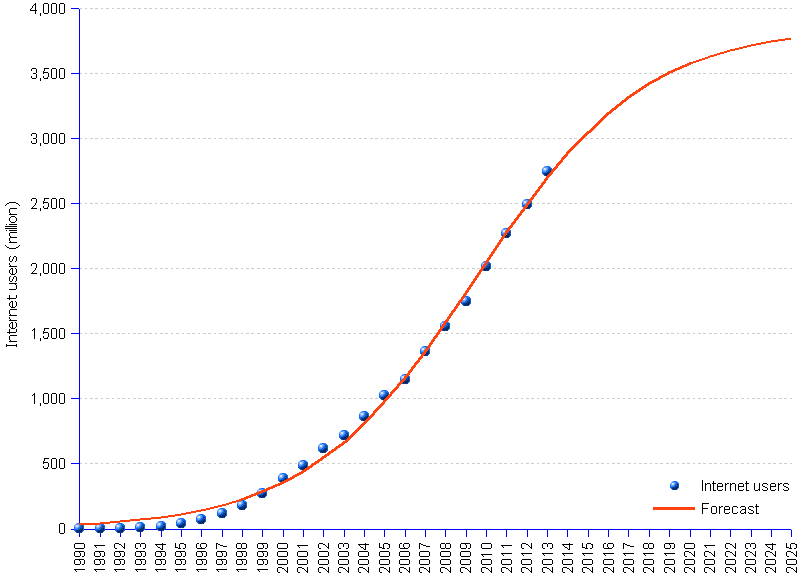
The number of world Internet users is estimated by International Telecommunications Union (ITU) to reach 2.75 billion by end 2013 (blue dots in the chart). In other words, 39 per cent of the world’s population will be using the Internet by end 2013, which implies that there are still 4.4 billion people who are not yet online.
Internet usage is likely to continue growing for some more years, reaching 90% of total potential market as soon as 2019, to ascend up to areppim's estimated saturation point of 3.9 billion users (red line in the chart) to happen before 2030 — compare with 2012, 2010and 2008 forecasts. Historical data covering the period 1990-2013 reveal that growth has been exponential at the average annual rate of 35.27 % until the inflection point in 2010, when volume reached 1.9 billion, corresponding to 29.3% of the world population. Thereafter growth started to slowly decelerate.
A key basic indicator to monitor consumer adoption is the number of households with access to the Internet. The number of households with Internet access is increasing in all regions, but large differences persist between developed and developing countries, with penetration rates set to reach almost 80 per cent in the former compared with 28 per cent in the latter. The table hereinafter shows, however, that the number of households with Internet access at home has been growing more than twice as fast in the developing, than in the developed world.
| Households with Internet access at home (per 100 inhabitants) | |||
| Developed | Developing | World | |
| 2005 | 44.7 | 8.1 | 18.4 |
| 2006 | 48.2 | 9.6 | 20.5 |
| 2007 | 53.4 | 11.2 | 23.0 |
| 2008 | 57.7 | 12.5 | 25.0 |
| 2009 | 62.6 | 14.1 | 27.4 |
| 2010 | 66.3 | 16.4 | 30.0 |
| 2011 | 70.2 | 20.2 | 33.6 |
| 2012 | 74.0 | 24.0 | 37.4 |
| 2013 | 77.7 | 28.0 | 41.3 |
| Average annual growth | 7.17% | 16.70% | 10.59% |
There are many reasons why households in developing countries are not as yet connected to the Internet, primarily related to the affordability and availability of Internet services. The continued increase in wireless broadband deployment and services, coupled with falling prices, should improve Internet access in households in developing regions over the next years. A powerful enabler is the shift in the type of Internet access devices used in households, which are no longer limited to computers, but increasingly include other devices, such as smart-phones.
Indeed, there is a clear likelihood that mobile Internet services, in other words access to Internet services through cellular phones and other mobile devices, could induce a surge of the number of Internet users, both in developing and developed countries, possibly causing them to exceed the 3.9 billion saturation point, in the same way mobile phone caused the explosion of the number of telephone subscribers.
World Internet Users | ||||
Year | Number | World Population | Internet penetration | |
| Actual | Forecast ¹ | Million | % Pop ² | |
| 1990 | 2.64 | 35.063 | 5,295 | 0.05% |
| 1991 | 4.4 | 44.495 | 5,382 | 0.08% |
| 1992 | 7 | 56.427 | 5,467 | 0.13% |
| 1993 | 10 | 71.5 | 5,552 | 0.18% |
| 1994 | 21 | 90.502 | 5,636 | 0.37% |
| 1995 | 40 | 114.402 | 5,719 | 0.70% |
| 1996 | 74 | 144.372 | 5,802 | 1.28% |
| 1997 | 117 | 181.814 | 5,883 | 1.99% |
| 1998 | 183 | 228.369 | 5,964 | 3.07% |
| 1999 | 275 | 285.921 | 6,045 | 4.55% |
| 2000 | 390 | 356.554 | 6,124 | 6.37% |
| 2001 | 489 | 442.48 | 6,203 | 7.88% |
| 2002 | 616 | 545.891 | 6,281 | 9.81% |
| 2003 | 721 | 668.749 | 6,359 | 11.34% |
| 2004 | 867 | 812.491 | 6,437 | 13.47% |
| 2005 | 1,024 | 977.68 | 6,515 | 15.72% |
| 2006 | 1,151 | 1163.654 | 6,593 | 17.45% |
| 2007 | 1,365 | 1368.244 | 6,671 | 20.46% |
| 2008 | 1,556 | 1587.668 | 6,750 | 23.06% |
| 2009 | 1,747 | 1816.685 | 6,828 | 25.59% |
| 2010 | 2,023 | 2049.024 | 6,907 | 29.29% |
| 2011 | 2,273 | 2278.041 | 6,985 | 32.54% |
| 2012 | 2,497 | 2497.465 | 7,063 | 35.35% |
| 2013 | 2,749 | 2702.055 | 7,141 | 38.49% |
| 2014 | 2888.029 | 7,218 | 40.01% | |
| 2015 | 3053.218 | 7,295 | 41.85% | |
| 2016 | 3196.96 | 7,371 | 43.37% | |
| 2017 | 3319.818 | 7,447 | 44.58% | |
| 2018 | 3423.229 | 7,521 | 45.51% | |
| 2019 | 3509.155 | 7,595 | 46.21% | |
| 2020 | 3579.788 | 7,667 | 46.69% | |
| 2021 | 3637.34 | 7,738 | 47.00% | |
| 2022 | 3683.895 | 7,808 | 47.18% | |
| 2023 | 3721.337 | 7,877 | 47.24% | |
| 2024 | 3751.307 | 7,945 | 47.22% | |
| 2025 | 3775.207 | 8,011 | 47.13% | |
| ¹ Logistic growth function | ||||
| ² Internet users as percent of world population; actuals until 2013, forecasts thereafter. | ||||
Source: ITU International Telecommunications Union